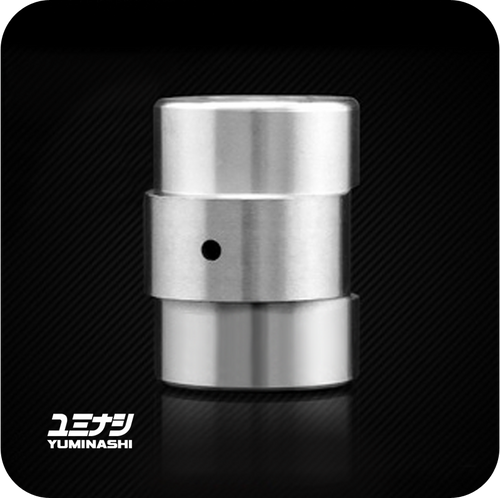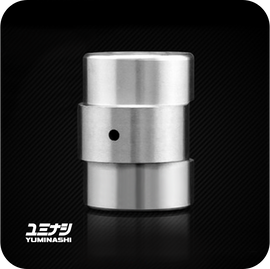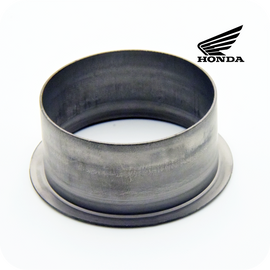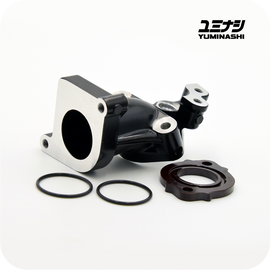3MM OFFSET STROKER PIN Ø28MM X L43MM (PCX125/150 - ADV150 - CLICK125/150)
Brand : YUMINASHI
- SKU:
- 13381-KWN-300
- Availability:
- Fast moving item, ships the next day (except on Thai public holidays)...
- Weight:
- 200.00 Grams
- Minimum Purchase:
- 1 unit
- Shipping:
- Calculated at Checkout
 ● YUMINASHI 3MM OFFSET STROKER PIN Ø28MM X L39MM (PCX125/150 - ADV150 - CLICK125/150 - ETC...) (13381-KWN-300)
● YUMINASHI 3MM OFFSET STROKER PIN Ø28MM X L39MM (PCX125/150 - ADV150 - CLICK125/150 - ETC...) (13381-KWN-300)
● YUMINASHI 3mm Offset Stroker Pin (0.07874 inches), to increase the stroke of your stock crankshaft with 6mm (0.23622 inches).
● The diameter of this offset stroker crankpin is Ø28mm, the length is 43mm.
※ Check before you order if a crankpin with these specification is what you are looking for.
※ The special needle bearing is not included, you can order the SPL needle bearing for this crank with this LINK.
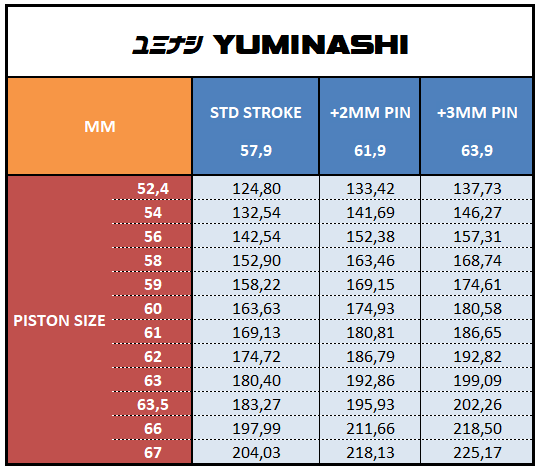
● THE 13381-KWN-300 3MM OFFSET STROKER PIN Ø28MM X L43MM IS THE CORRECT CRANK PIN TO BE INSTALLED ON:
HONDA:
- Honda ADV150 (2019- )
- Honda AIR BLADE125 (ALL)
- Honda AIR BLADE150 ABS (2019- )
- Honda CLICK125i (ALL)
- Honda CLICK150i (2018- )
- Honda LEAD125 (2013- )
- Honda PCX125 (2012- )
- Honda PCX150 eSP (2012-2014)
- Honda PCX150 LED & SMART KEY (2014-2018)
- Honda PCX150 DIGITAL (2018- )
- Honda PCX150 HYBRID (2018- )
- Honda SH125i (2013- )
- Honda SH125i MODE (2014- )
- Honda SH 150i (2013-2018)
- Honda SH 150i LED (2018- )
- Honda VARIO / VARIO TECHNO (ALL)
- Honda VARIO150 LED (2015 - 2018)
- Honda VARIO150 DIGITAL (2018- )
LAMBRETTA:
- LAMBRETTA V125 (ALL EDITIONS)
- LAMBRETTA V200 (ALL EDITIONS)
ROYAL ALLOY:
- ROYAL ALLOY GP125
- ROYAL ALLOY GT125
- ROYAL ALLOY TG125
- ROYAL ALLOY TG180
- ROYAL ALLOY GP150
- ROYAL ALLOY GP180
SCOMADI:
- SCOMADI TECHNICA 125i (CUTDOWN)
- SCOMADI TL125
- SCOMADI TT125i
※ Keep in mind that a longer stroke crankshaft will required an aluminium spacer to be installed underneath your cylinder, and that you will need to use 2 cylinder base gaskets, a longer cam chain and usually 2 extra dowel pins.
Keep also in mind that depending on the connecting rod length you are using, you will need to install most likely also 4 new, longer cylinder studs.
![]() TUNING TIPS & THINGS TO CONSIDER ABOUT STROKE/CONROD RATIO'S:
TUNING TIPS & THINGS TO CONSIDER ABOUT STROKE/CONROD RATIO'S:
● We recommend for a powerful and reliable engine a stroke/connecting rod ratio of 1.75
● All 125 and 150 scooters above have a 57.9mm crankshaft installed, and you can calculate the recommended connecting rod length like this:
57.9mm x 1.75= 101.33mm for the recommend connecting rod length, or something close to this number such as 100mm.
If you install this 3mm stroker pin which increases the stroke in total with 6mm, from 57.9 to 63.9mm stroke, then we recommend a connecting rod length of:
63.9mm stroke x 1.75= 111.83mm conrod length, or something close to this number such as 110mm.
● We recommend the 1.75 ratio over a lower ration because generally, a lower ratio means a high rod angle, creating greater potential for accelerated wear to cylinder walls, piston skirts and rings; the increase in friction can also raise coolant temps.
A low ratio can also lead to higher levels of engine vibration.
A low enough ratio, due to the severity of its rod angle, can drive a piston right into the cylinder wall.
Higher ratio engines, on the other hand, don't have the same friction concerns, but compromise in other areas.
Air does not fill the intake ports with the same velocity, and there is less demand for the ports to flow as well since there is more time to fill and scavenge the cylinder (we discuss this phenomenon later).
A longer rod makes more torque with the same piston force, and since it's less angular than a shorter rod, reduces sidewall loading and decreases friction.
All of this adds up to more power.
Longer rods also give the pistons more "dwell," the brief periods of time the piston is at top dead center and bottom dead center.
A longer dwell allows for better flow of intake and exhaust gases since the piston moves slower between up- and downstrokes.
Longer dwell also offers more time to fill the cylinders during the intake stroke and more time to scavenge during overlap. And since the piston hangs out at or near TDC longer, the combustion stroke has more time to deliver a thorough release of energy on to the piston.
In a stroked motor, the piston ultimately reaches greater speeds to cover the additional stroke. The speed makes intake, compression and exhaust strokes more turbulent and, consequently, more powerful. It also comes with its price in component wear, something to consider when looking into parts that increase stroke.
With a short stroke and a long rod, however, the piston accelerates more gently from TDC. It picks up its greatest speed further down the bore, at the point where the crank pin relative to the rod angle reaches 90 degrees. Since the pistons move from TDC slower, the entire bottom end absorbs less mechanical stress.
● Most engine builders believe longer rods are better, but some enthusiasts still dig the low-rpm torque that shorter rods can make.
We advise builders who want a ratio of less than 1.6:1 to use the strongest aftermarket rods they can find, given the angle.
We also recommend with a 1.6 ratio or less aftermarket sleeves to better fend off the lateral stress created by the rod angle.
![]() SMART SHOPPER TIP:
SMART SHOPPER TIP:
※ BUYING MORE THAN 1 PIECE CUT THE TRANSPORT PRICE, AND YOU RECEIVE A 10% DISCOUNT ON TOP OF IT!
※ B2B:
- Purchases between 2 & 4 pieces of this product will receive a 10% DISCOUNT
- Purchases between 5 & 9 pieces of this product will receive a 15% DISCOUNT
- Purchases between 10 & 19 pieces of this product will receive a 20% DISCOUNT
- Purchases between 20 & more pieces of this product will receive a 25% DISCOUNT

 Thai Baht
Thai Baht
 US Dollar
US Dollar
 Euro
Euro
 Pound Sterling
Pound Sterling
 Japanese Yen (¥)
Japanese Yen (¥)
 Australian Dollar
Australian Dollar
 Canadian Dollar
Canadian Dollar
 Russian Ruble
Russian Ruble
 Indonesian Rupiah
Indonesian Rupiah
 Malaysian Ringgit
Malaysian Ringgit
 Polish Złoty
Polish Złoty
 Czech Koruna
Czech Koruna
 Brazilian Real
Brazilian Real
 South African Rand
South African Rand
 Philippine Peso
Philippine Peso
 South Korean Won
South Korean Won
 Indian Rupee
Indian Rupee
 Vietnamese Dong
Vietnamese Dong
 Israeli Shekel
Israeli Shekel
 Hong Kong Dollar
Hong Kong Dollar
 CFP Franc
CFP Franc
 Swiss Franc
Swiss Franc
 Swedish Krona
Swedish Krona
 Turkish Lira
Turkish Lira

